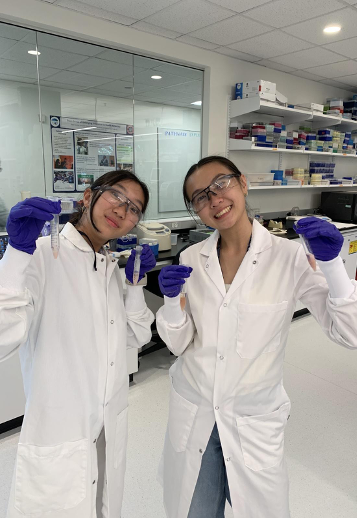Jessica S.
- SEP

- Sep 18, 2025
- 3 min read
Over the past two weeks, the Fred Hutchinson Explorers Program provided me with an excellent foundation for learning how cancer affects and maneuvers throughout the human body. Furthermore, it introduced all students to different career paths through biology and biomolecular research with pivotal lectures about bioethics, immunology, statistics, and more. This experience has significantly amplified my interest in the biological sciences and research fields.

Group polaroid taken on the first day in the lab
Every day there were either labs, lectures, or tours that heightened my interest in the biomolecular research aspect of medicine. Throughout the two busy weeks of this program, I have learned so much about the different hallmarks and types of cancer. These experiences made me want to deliberately focus on how we can find cures for these fatal cancers. Near the end of the program, we performed our own PCRs and gel electrophoresis experiments that taught us how to conduct and test for diseases of different “patients.” It was so memorable and fulfilling to see each lab group look satisfied when they successfully completed their own lab procedures with minimal assistance from the TAs. These independent lab experiments not only boosted my curiosity for research but also affirmed my intended plan for collegiate studies in the healthcare field.

My partner Priya and my last gel electrophoresis lab results
As fun as all the labs were, the neighborhood tours were equally fascinating. I was able to see the amazing research facilities around the South Lake Union area, specifically the Allen Institute. In this gorgeous building, I saw how different floors were designated for various research projects, including autoimmune diseases, neural dynamics, cellular sciences, and cancer studies.

Me leaning to watch C elegans get injected with CRISPR Cas9 to genetically modify the worm genome

The Allen Institute tour with a side of stairs
One lab that I found particularly fascinating was the Stoddard Lab, which focuses mainly on protein structural engineering. Dr. Stoddard uses advanced technology and computer imagery to design and replicate intricate 3D structures at the atomic level to modify these proteins in hopes of curing various human diseases. He creates crystalized proteins and puts them in a fancy machine where he blasts them with liquid nitrogen to end up with multiple 2D images that are sent to a computer to create a 3D model of the protein. His goal of using engineered proteins alongside enzymatic catalysts to correct deadly mutations is something that I find remarkable. I think that this convoluted process using protein crystallization, specialized machines, and advanced computer engineering is incredibly fascinating and might be something I want to study in the future.

Barry Stoddard’s crystalized proteins under a microscope

This is the machine that a crystalized protein goes into for imaging with the high-tech camera and other equipment
The Explorers program has greatly elevated my curiosity within biological sciences, engineering, and research by giving me an opportunity to explore pathways I never knew existed. I am forever grateful for having been a part of this amazing program through Fred Hutch. I strongly believe that the critical insights I have learned and networks that I have created are things that will remain with me for many years to come. I would like to give a special thanks to Dr. G; our amazing director, Layan and Lac; our supportive TAs, and all the lecturers, doctors, and the other explorers for providing an unforgettable experience!







Comments